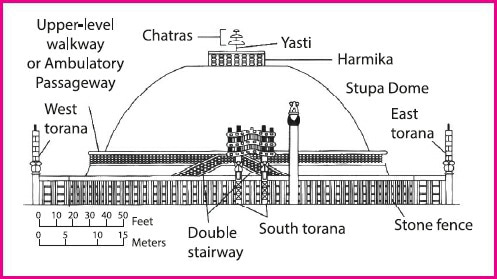Sanchi Stupa | 14 Sep 2024
Why in News?
Recently, India’s External Affairs Minister visited the replica of the East Gate of Sanchi Stupa standing in front of Humboldt Forum museum in Berlin, Germany.
Key Points
- Construction of Sanchi Stupa: It was built by Ashoka in the third century BC.
- Its construction was overseen by Ashoka’s wife Devi, who hailed from the nearby trading town of Vidisha.
- The development of the Sanchi complex was supported by patronage from Vidisha’s mercantile community.
- Expansion: During the 2nd century BC (Shunga period), the stupa was enlarged with sandstone slabs, a circumambulatory walkway, and a harmika with a chattra (umbrella).
- From the 1st century BC to the 2nd century AD, four stone gateways or toranas were added, adorned with detailed carvings depicting Buddhist iconography and stories.
- Rediscovery of Sanchi Stupa: It was in abject ruins when it was discovered by British officer Henry Taylor in 1818.
- Alexander Cunningham led the first formal survey and excavations at Sanchi in 1851.
- Preservation Efforts: In 1853, Sikander Begum of Bhopal offered to send Sanchi gateways to Queen Victoria, but the removal plans were delayed due to the 1857 revolt and transportation issues.
- In 1868, the Begum renewed the offer, but the colonial authorities declined it, opting for in-situ preservation. A plaster cast of the eastern gateway was created instead.
- The site was restored to its present condition by Archaeological Survey of India (ASI) director-general John Marshall in the 1910s with funding from the begums of nearby Bhopal.
- Marshall’s efforts led to the creation of a museum in 1919 at the site to preserve artefacts and manage conservation.
- Architecture of Sanchi Stupa:
- Anda: It is a hemispherical mound built on earth.
- Harmika: Square railing on top of the mound. It is believed to be the living place of god.
- Chattra: It is the umbrella built on the top of the dome.
- Yashti: It is the central pillar supports a triple umbrella structure called chattra.
- Railing: It surrounds the stupa, demarcating the sacred area and providing a physical boundary between the holy space and the external environment.
- Pradakshinapatha (Circumambulatory Path): It is a walkway around the stupa that allows devotees to walk in a clockwise direction as a form of worship.
- Torana: Torana is a monumental gateway or entrance structure in Buddhist stupa architecture.
- Medhi: It refers to the base which forms a platform on which the main structure of the stupa stands.
- UNESCO Recognition: Sanchi Stupa was inscribed as a UNESCO World Heritage site in 1989.

